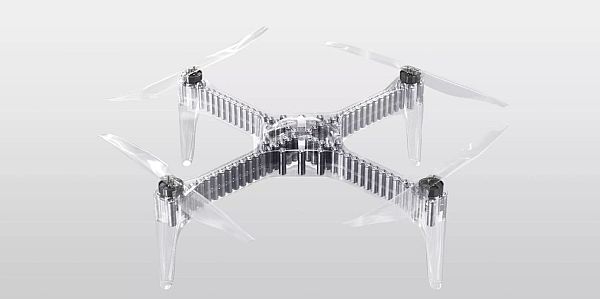Podcast: Play in new window | Download (Duration: 31:41 — 21.8MB)
Impossible Aerospace US-1 quadcopter, a triple-powered hybrid drone, an Amazon patent for a data services drone, more industry consolidation, flying robots and intelligent architecture, the impulse to deploy drones after a hurricane.
UAV News
Impossible Aerospace, founded by former Tesla engineer launched a new drone with a two-hour flight time
The Impossible Aerospace US-1 features arms and a body filled with Lithium Ion battery cells. The 26-inch frame quadcopter has planned availability in the fourth quarter of 2018 at $7,000 plus accessories. With a two-hour flight time, target customers include first responders, firefighters, police, and coastguards. Impossible Aerospace is a U.S. start-up founded in 2016 by former Tesla battery design engineer Spencer Gore. The company has $9.4 million in Series A funding with backing by Bessemer Venture Partners, Eclipse Ventures, and Airbus Ventures.
This world-first drone is a fuel triple threat
University of Sydney researchers have developed a fixed-wing drone powered by a triple hybrid propulsion system – hydrogen fuel cell, battery, and a supercapacitor. The supercapacitor provides load smoothing to increase fuel cell life and also improves the dynamic response of the overall propulsion system.
A drone that’s an on-demand data server? The perfect patent for Amazon’s ambitions
The Amazon “Unmanned Aerial Vehicle Data Services” patent contemplates a drone that can be deployed on demand to a network user to provide enhanced data services. The drone could carry communications equipment or the user could upload data to the drone, after which the drone flies off to transfer data to a central server.
PrecisionHawk strengthens positions in energy, insurance markets
PrecisionHawk has purchased HAZON Solutions LLC and InspecTools Inc., companies that specialize in energy industry drone inspections. PrecisionHawk also announced a partnership with EagleView Technologies Inc., which provides aerial imagery and data analytics.
“Live” shapeshifting canopy uses drones to keep guests in the shade
The University of Stuttgart “Cyber Physical Macro Materials” project used flying robots to create intelligent architecture. The prototype is an adaptive canopy that changes its configuration as the sun changes position. A self-supporting roof structure has a canopy made of smart-panels, which connect with autonomous drones. The drones use grippers to assemble the panels as needed to maintain a shaded area throughout the day. Another algorithm can detect people underneath and change panels to keep the crowd cool.
Self-Deploying Drone Pilots a Problem for Hurricane Response Efforts
Drones have proven themselves to be valuable for emergency management, such as after hurricanes, floods, wildfires, and natural and man-made disasters. Well-intended drone pilots are tempted to launch, but “most drone operators do not possess the fundamental training, skills, and experience to be truly effective.” Drone flights can interfere with public safety and government agencies, and critical infrastructure providers such as power or telecommunications companies. Drone pilots can find also find themselves part of the problem and become stranded without food, water, and gas. Disaster response requires training, coordination with authorities, and deployment based on orders.
The North Carolina Department of Public Safety created the North Carolina Unmanned Aerial System (UAS) Disaster Response Database that “provides local Emergency Managers and First Responders with a list of qualified UAS pilots that are willing to provide services to their community. Participating UAS pilots have successfully completed their FAA Part 107 qualification and are NCDOT Certified Government Operators.”

